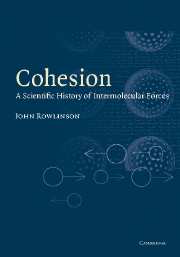5 - Resolution
Published online by Cambridge University Press: 27 July 2009
Summary
Dispersion forces
The understanding of cohesion has two main strands; first, what are the forces between the constituent particles of matter and, second, how does the operation of these forces give rise to the transformation of gases into liquids, liquids into solids, and to all other manifestations of cohesion, of which the elasticity of solids and the surface tension of liquids have, throughout the years, been the two that have attracted most attention. We have seen that in the 18th century there were some interesting speculations about the form of the forces, in particular that they fell off with r, the separation of the particles, as r-n, where n is greater than 2, its value for the law of gravitation. The second strand received some attention at this time but little progress was made. The situation was reversed by Laplace who found that he had to dismiss speculation about the nature or form of the forces with the dictum that all we could know of them was that they were ‘insensible at sensible distances’. He made, however, a substantial contribution to the second strand of the problem with his theory of capillarity and, in the hands of his followers, his ideas proved fruitful, if controversial, in the interpretation of the elastic properties of solids. No further progress could be made until the kinetic theory and the laws of thermodynamics had been established.
- Type
- Chapter
- Information
- CohesionA Scientific History of Intermolecular Forces, pp. 234 - 320Publisher: Cambridge University PressPrint publication year: 2002



